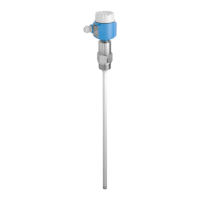Commissioning Liquicap M FMI51 HART
44 Endress+Hauser
2.
Press the key to start uploading from the sensor to the electronic insert.
The green LED flashes for 2 s, confirming your entry.
The device restarts.
7.3 Menu: "Basic setup". Commissioning with display and
operating module
This section describes how to commission the Liquicap M, the display and the
operating module. The procedure for commissioning through FieldCare, DeviceCare or
FieldXpert handheld terminal is the same. More detailed information can be found in
the Operating Instructions for FieldCare BA 224F/00 supplied together with the
handheld terminal.
7.3.1 Initial commissioning
On the first power-up, you are requested to select the language for the display texts. After
this selection, the measured value is displayed.
If a reset is performed at the device and if the power supply is switched off and on
again, the language of the display texts has to be selected again.
Menu structures: Main menu
The main menu is activated by means of the right Enter key .
The following menu headings appear. These are explained in more detail over the
following pages:
• Basic setup → 46
• Safety setting → 52
• Linearization → 57
• Output → 62
• Device properties → 65
Liquicap M devices are calibrated on leaving the factory for media with a conductivity
of ≥ 100 µS/cm. Recalibration is only necessary if the 0 % value or the 100 % value
should be adjusted to suit customer-specific requirements, the distance to the tank
wall is < 250 mm (9.84 in) or if the liquid is not conductive.
A distinction is generally made between two types of calibration:
• Wet calibration
During wet calibration, the probe must be covered by a liquid in the installed state.
This calibration can be done if the tank is empty, full or partially full. Empty and full
calibration must be performed.
• Dry calibration
During dry calibration, empty and full calibration can done without the probe being
in contact with the liquid. The calibration values can be entered directly in units of
length.

